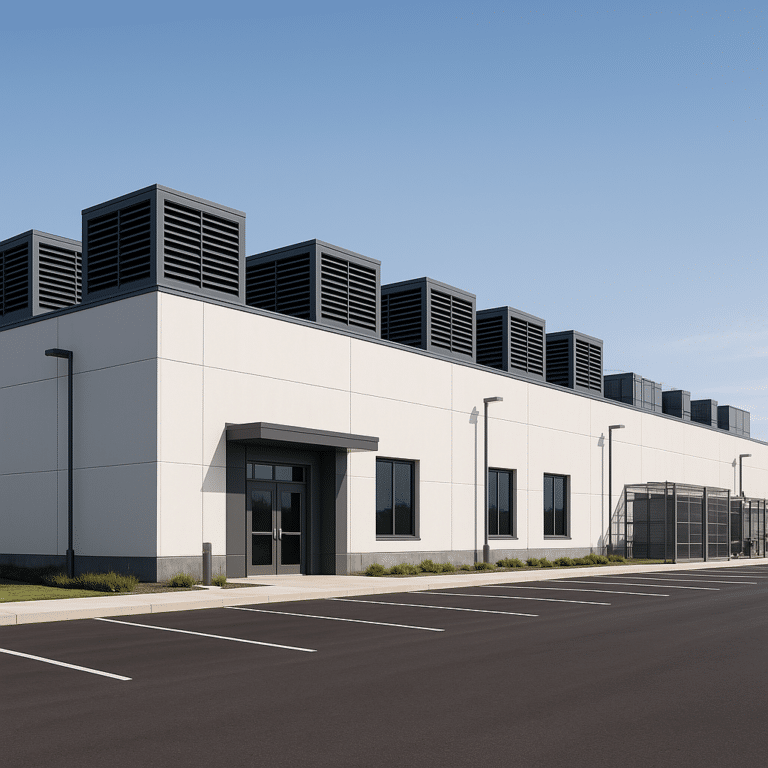Data Centers Risk Management: Builders Risk & Workers Compensation Strategies
Data centers are the backbone of the digital age. They process and store critical information that supports businesses around the globe. Today, protecting these facilities is essential. In this guide, we show you how to integrate Builders Risk Insurance and Workers Compensation to safeguard your data center investment. This approach protects both your physical assets and your workforce.
The Evolving Risks of Data Centers
Modern data centers face many risks. They must protect expensive equipment and support non-stop operations. Here are the key challenges:
Technological Complexity and High-Value Equipment
Data centers use advanced servers, cooling systems, and power units. These items cost a lot and need careful handling. Insurance policies must cover them. Insurers also need to allow for upgrades and rapid obsolescence.
Dynamic Threats and Operational Challenges
Data centers face natural disasters, cyber threats, and human errors. A water leak or a power failure can cause huge losses. Operators must act quickly. Breaking risks into smaller parts helps teams respond faster.
The Need for Continuous Uptime
Even short downtime can cost millions. Data centers must operate 24/7. Insurance plays a key role in preventing delays during construction and interruptions during operation.
Detailed Pricing Information for Data Center Risk Management
When budgeting for integrated risk management, it helps to have a clear idea of the specific cost ranges involved. Here are more detailed price insights:
-
Builders Risk Insurance:
-
Generally costs 0.5% to 2.5% of the total construction budget.
-
For a data center with a $10 million construction cost, expect premiums between $50,000 and $250,000.
-
In high-risk locations or with advanced technology, rates may edge toward the higher end of this range.
-
-
Workers Compensation Insurance:
-
Costs typically range from $1.00 to $3.00 per $100 of payroll.
-
For an annual payroll of $1 million, this results in $10,000 to $30,000 per year.
-
Higher risk roles or poor safety records may push premiums upward, sometimes exceeding $3.00 per $100 of payroll.
-
-
Additional Cost Considerations:
-
Risk Mitigation Measures: Investments in safety training, ergonomic improvements, and real-time monitoring systems can add $5,000 to $20,000 to the initial setup costs but may reduce long-term claims.
-
Premium Adjustments: Regular reviews and updates of risk assessments might adjust your coverage needs, causing fluctuations of 5-10% in your annual premiums.
-
Bundled Policies: Some insurers offer discounts when combining Builders Risk and Workers Compensation into an integrated risk management package, which might reduce overall costs by 10-15% compared to separate policies.
-
These numbers provide a framework for understanding the financial commitment required. Each project’s specifics—such as location, technology level, and workforce safety measures—will ultimately influence the exact figures. Collaborating with experienced insurance brokers and conducting detailed risk assessments can ensure your estimates align closely with actual exposure and project needs.
Builders Risk Insurance for Data Center Construction
Builders Risk Insurance protects construction projects from unexpected events. For data centers, this policy must be very specific.
Protecting High-Tech Infrastructure
This insurance covers more than just buildings. It also covers servers, cooling systems, and power supplies. Insurers should add endorsements that include modern technology. For example, a policy might cover upgrades as technology changes.
Outbound Link: Read more about Builders Risk Insurance on the Insurance Information Institute
Dynamic Coverage Limits
Data centers evolve as they are built. Insurers should adjust coverage limits over time. This means they can cover new equipment or enhancements as the project grows. Setting flexible limits protects your investment better.
Environmental and Catastrophe Endorsements
Many data centers sit in areas prone to storms or earthquakes. Endorsements can extend coverage for these risks. Insurers may use predictive analytics to set premiums. This proactive step protects your project from natural disasters.
Real-World Example: Quick Leak Response
In one project, a water leak appeared due to a faulty cooling pipe. Real-time sensors detected the leak immediately. Maintenance crews fixed the issue fast. The policy covered the repairs and saved the project from delays.
Workers Compensation for a Safer Data Center
Workers Compensation is key for protecting your team. It covers medical bills, lost wages, and rehabilitation costs. Here’s how you can improve safety:
Training Programs and Clear Safety Protocols
Data center projects involve construction and high-tech work. Employees need training that covers both areas. Use hands-on sessions and simulations to build safety skills.
Health, Wellness, and Ergonomics
Workplace injuries can hurt productivity. Regular ergonomic assessments and health screenings help reduce injuries. Programs that support mental and physical well-being boost morale.
Fast and Efficient Claims Management
When accidents happen, fast action is crucial. Use a digital claims management system. This system tracks incidents in real time and speeds up claim resolution. It also helps you learn from each case.
Outbound Link: Visit the U.S. Department of Labor for Workers Compensation guidelines
Real-World Example: Quick Injury Response
In one case, a worker was injured while cleaning up a water leak. The digital system documented the incident right away. The worker received prompt care and returned to work soon. This active approach kept the project on track.
Using Technology and Data Analytics to Improve Risk Management
Modern tools make risk management smarter. They allow you to monitor and analyze risks continuously.
Real-Time Monitoring with IoT
Sensors and IoT devices monitor conditions at the construction site and within the operational facility. They alert staff when a problem appears. Quick alerts let you fix issues before they grow.
Predictive Analytics for Preemptive Action
Predictive analytics use past and current data to forecast problems. With these insights, you can adjust policies or add safety measures before incidents occur.
Centralized Risk Management Platforms
Combine data from Builders Risk and Workers Compensation systems on one dashboard. This central system simplifies reporting and speeds up decision-making. It keeps both physical assets and employee safety in focus.
Emerging Trends in Data Center Risk Management
As data centers evolve, risk management must also change. Here are some trends to watch:
Cyber-Physical Convergence
Today’s data centers blend digital and physical systems. Cyberattacks can have real-world effects, like disrupting cooling systems. Future policies may need to combine Builders Risk with cyber insurance.
Modular and Scalable Construction
Modular designs let you build data centers faster. However, they introduce new risks. Insurers now offer policies that cover the unique challenges of modular construction.
Sustainability and Green Building Practices
Data centers now use eco-friendly materials and energy-saving systems. These changes create new risks. Insurers are updating policies to cover green technologies and sustainable practices.
Enhanced Data Analytics and AI
Artificial intelligence helps detect risk patterns quickly. AI can analyze huge amounts of data to predict potential problems. This innovation drives faster claims and better safety outcomes.
Best Practices for Integrated Data Center Risk Management
Use these tips to merge Builders Risk and Workers Compensation effectively:
Conduct Holistic Risk Assessments
Perform regular risk audits. Include construction and operational risks. Engage cross-functional teams like IT, facilities management, and safety experts.
Collaborate with Insurance Experts
Work with brokers who understand data center challenges. Their expertise can help customize policies. They also spot any coverage gaps you may have.
Invest in Continuous Training and Safety Improvements
Update training sessions and safety drills regularly. Use both classroom lessons and hands-on simulations. This approach improves your safety culture.
Leverage Technology for Better Monitoring
Install digital tools to track construction progress and safety issues. Use predictive analytics to catch problems early. A centralized dashboard keeps your risk data in one place.
Establish a Centralized Claims System
Integrate claims for Builders Risk and Workers Compensation into one system. This streamlines communication and speeds up claim resolution. It also helps you spot recurring issues.
Real-World Success Stories
Real examples show how integrated risk management makes a difference.
Example 1: Storm Damage Mitigation
In one coastal project, a severe storm damaged parts of the construction. The Builders Risk policy quickly covered the repairs. This fast response kept the project on schedule.
Example 2: Efficient Injury Management
A worker injured on site received immediate treatment through a digital claims system. This prompt care reduced downtime and supported a speedy return to work.
Example 3: Unified Risk Data for Better Decisions
Another project used a centralized dashboard. It combined claims data from both insurance types. The data helped managers improve safety protocols and reduce future incidents.
Conclusion: Future-Proof Your Data Center
Integrating Builders Risk Insurance with Workers Compensation offers complete protection. This strategy protects both your physical assets and your workforce. With clear policies and modern technology, you can keep your data center running smoothly.
Adopt this integrated approach to build smarter and safeguard your future. Protect your investment, ensure continuous operations, and create a safe environment for your employees. Use proactive measures and cutting-edge tools to stay ahead of potential risks.
For more information on managing risks in modern data centers, visit our Risk Management Insights page and check out this guide on modern insurance strategies.
Secure your data center investment today. Build smart, protect your team, and lead your industry with confidence.


